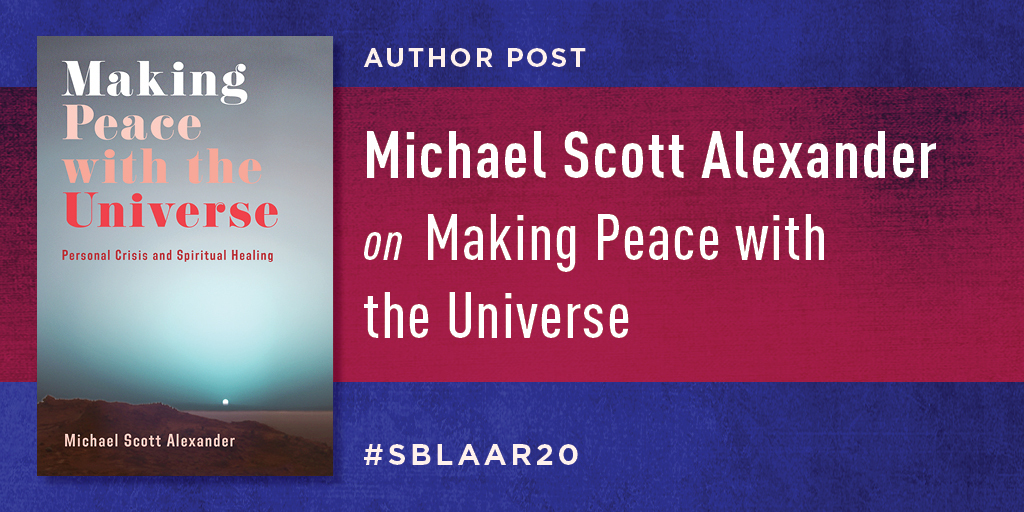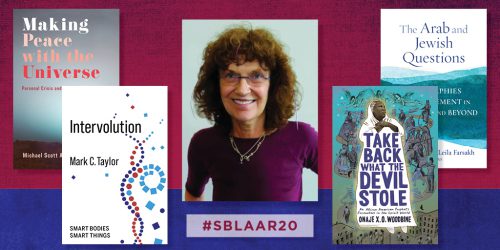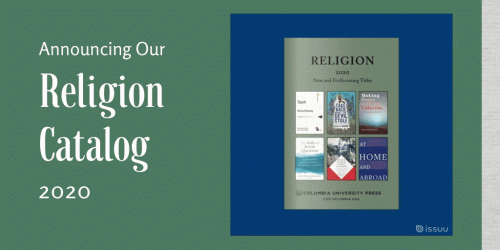Michael Scott Alexander on Making Peace with the Universe

“A brilliant exploration of religious and spiritual experiences as they relate to the ability to heal the mind and promote psychological health. A missing piece of the puzzle of how religion intersects with psychological wellbeing.”
~Andrew Newberg, author of Neurotheology: How Science Can Enlighten Us About Spirituality
The world’s great religious and philosophical traditions often include poignant testimonies of spiritual turmoil and healing. In today’s SBL/AAR Annual Meetings virtual exhibit post, Michael Scott Alexander opens up about his personal turmoil and how it led him to write Making Peace with the Universe: Personal Crisis and Spiritual Healing.
• • • • • •
In my mid-thirties, having abandoned a failed project in my home field of Jewish Studies, I began to retreat from my dedication to a career in the academic study of religion. Both professionally and personally, everything had started to feel pointless to me. Anyone who has taught about religion knows that so much doctrine merely supports the bluntest political aims— sexism, racism, sexual phobia, and, these days especially, nationalism. In the classroom, I felt obliged to remind thinking students of this impolite history. Yet in private I still found myself wondering: But is there anything to it? I realized I needed to test any purported therapeutic affects for myself—once and for all, in this life, now. And so I decided to research the history and therapeutic efficacy of spiritual curiosity and adventure, hoping in reality to ignite my own.
Soon I discovered something that shocked me. Many others in the long history of the human record had also asked these kinds of questions about the value of spiritual exploration, and typically also during personal crises. I realized this while coming to review the first sentence of Dante’s Inferno, which in midlife now halted me.
Midway upon the journey of our life
I found myself within a forest dark
For the straightforward path had been lost.
Suddenly Dante’s famous journey through hell and redemption reflected a pattern I could see represented in so many spiritual masterpieces I knew. These in effect comprised notes of personal breakdowns, typically set off by dark reminders of the human condition, whether illnesses and episodes of bodily demise, addictions, or just the silent pangs of purposelessness common to one’s midlife. Of course, I recalled right away Augustine’s Confessions (begun after a failed relationship), William James’s famous epiphanies with nitrous oxide that culminated in The Varieties of Religious Experience, and countless examples before and since. When had Socrates lost faith in sophistry, begun devotion to Apollo, and started denouncing the inanity of Athenian leaders? In his midlife after an existential crisis. Why had Ghazali, the Seljuq sultan’s legendary attorney, run away to Damascus to study mystical Sufi teachings? To reassess his life after the likely murder of his ruler. Even Genghis Khan began his spiritual study of the Dao while dreading a forced retirement due to an arrow to the knee. Less renowned contemporary cases also came to mind, such as that of my own jazz hero, the pianist Mary Lou Williams, who walked off stage mid-career in an alcoholic despair only to emerge writing the most gorgeous Catholic masses, insisting that these African American masterpieces be played at the Vatican. Pope Francis himself sought psychoanalytic therapy at the age of forty-two.
And so on. Like Dante, somewhere well along the path of life’s journey these capable and successful people lost track of themselves. Once they had seemed perfectly normal, with important day jobs and social responsibilities; then something happened, and they collapsed, doubting everything they had achieved. Still, with the onset of crisis, they did not take leave of reason. None claimed mysterious prophetic contact with divinity; none announced the godlike founding of a new faith. In fact, in their darkest moments of confusion and indirection, they all went and did something very normal, even reasonable: they sought spiritual grounding.
“Like Dante, somewhere well along the path of life’s journey these capable and successful people lost track of themselves.”
Fortunately, each also came to find that grounding. Their confessions ultimately portrayed the achievement of a kind of spiritual mood, a peace with the universe and with one’s place in it. This made some sense to me. Religion had certainly been the primary forum for therapy before scientific psychology existed. It was how one oriented oneself therapeutically amidst scarce resources and inhospitable environments. Yet I had never considered the classics of spiritual exploration and confession from an explicitly therapeutic point of view. I should have, because once I looked again, nearly all these of texts openly revealed these purposes: someone described a personal crisis and then recounted the steps taken to achieve personal reorientation. Nevertheless, after I began reconsidering these spiritual masterpieces, I never expected to find profound, radical, and even subversive therapeutic theories and practices. So my investigative purpose sharpened. I would now focus on the harrowing personal backstories to some classic works of spirituality to understand how therapeutics once operated and to see if these might still contribute to personal well-being.
Making Peace with the Universe consists of the stories of a few hurting people and how they came to locate higher powers for themselves, by which I simply mean how each found a personally orienting and therapeutic gravity. In all cases, this occurred after years of cynical beliefs and concomitant world-weary behaviors. Then, during a very personal crisis, each acquiesced to his or her total ignorance regarding personal well-being and so started over. In a sense, having reached the end of the reasoning tether, each finally let go, allowing the feeling of spiritual gravity itself to make the therapeutic adjustments.
“In the fog of living one can sometimes forget which of these ultimately feels therapeutic and which pathetic.”
None of their accounts advocated some painless Pollyanna perspective that just barely hid anxiety and fear. For how long could that have held together anything as complicated as a relationship or marriage, a family, a career—a life? Rather, each of our adventurers explored with utter emotional and intellectual honesty the nasty mess that living can be. Many people feel opposing tugs—toward gravity and toward emptiness. All the world’s scriptures and confessions are filled with this struggle. In the fog of living one can sometimes forget which of these ultimately feels therapeutic and which pathetic. Overcome by daily assaults, sometimes it seems easiest just to scurry after quick reliefs and releases, despite knowing all too well that, when pursued for themselves, these can come to feel more emptying than edifying. Yet, at the same time, a simple hope persists that there must be some better choice than the endless course of turning away. These geniuses also articulated this same hope and then went on to heal themselves. They did this by submitting their dark impulses to higher gravities and purposes.
All of us do this. In fact we do it all the time—in our families, in our friendships, in our schools and communities, in our vocations, and sometimes even in our places of worship. So perhaps in these masterpieces we will simply find a prompt or two to recall how our myriad and miraculous experiences of tranquil orientation are sometimes achieved. I mean the peace with the universe once felt by poet Wallace Stevens as he walked through the streets of New Haven one ordinary evening, breathed down deep, and, despite all the chaos, terror, and strife of life, could think to himself: “God is good. It is a beautiful night.”
Save 20 percent on our conference titles on display when you use coupon code AAR20 at checkout from our website by December 31, 2020.






